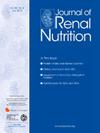Gastrointestinal Mucosal Cell Injury Caused by Sevelamer Crystals: Case Series and Literature Review
IF 3.2
3区 医学
Q2 NUTRITION & DIETETICS
引用次数: 0
Abstract
In end-stage kidney disease (ESKD), hyperphosphatemia occurs secondary to decreased renal elimination with continued intestinal absorption of dietary phosphate. Even in chronic kidney disease, glomerular filtration rate lower than 30 mL/min markedly decreases the filtration of inorganic phosphate and increases its serum level. Sevelamer, a noncalcium phosphate binder, is commonly used to control hyperphosphatemia. Available in 2 forms, sevelamer hydrochloride and sevelamer carbonate, it absorbs phosphate in the gastrointestinal tract and is known to have minimal adverse effects. These are limited to nausea, vomiting, flatulence, and metabolic acidosis, with infrequent significant adverse outcomes. We present a series of 2 patients with ESKD on sevelamer, with lower gastrointestinal bleeding and endoscopic findings of colonic mucosal injuries with histopathological findings of sevelamer crystals deposition.
Although reported in gastrology literature, nephrology reports show a paucity of discussion around this increasingly common adverse effect and the need for vigilance in ESKD.
sevelamer晶体引起的胃肠道粘膜细胞损伤-病例系列和文献复习。
在终末期肾病(ESKD)中,高磷血症继发于肾脏消除减少,并持续肠道吸收饮食中的磷酸盐。即使在慢性肾脏疾病中,肾小球滤过率低于30 ml/min时,无机磷酸盐的滤过率明显降低,血清中无机磷酸盐水平升高。Sevelamer是一种非磷酸钙粘合剂,通常用于控制高磷血症。有两种形式——盐酸西维拉默和碳酸西维拉默,它在胃肠道中吸收磷酸盐,已知副作用最小。这些局限于恶心、呕吐、胀气和代谢性酸中毒,很少有显著的不良后果。我们报告了两例因sevelamer而导致ESKD的患者,他们的下消化道出血和内镜下结肠粘膜损伤的发现以及sevelamer晶体沉积的组织病理学发现。虽然在胃肠学文献中有报道,但肾脏病学报告显示,关于ESKD日益常见的不良反应和警惕的必要性的讨论很少。
本文章由计算机程序翻译,如有差异,请以英文原文为准。
求助全文
约1分钟内获得全文
求助全文
来源期刊

Journal of Renal Nutrition
医学-泌尿学与肾脏学
CiteScore
5.70
自引率
12.50%
发文量
146
审稿时长
6.7 weeks
期刊介绍:
The Journal of Renal Nutrition is devoted exclusively to renal nutrition science and renal dietetics. Its content is appropriate for nutritionists, physicians and researchers working in nephrology. Each issue contains a state-of-the-art review, original research, articles on the clinical management and education of patients, a current literature review, and nutritional analysis of food products that have clinical relevance.
 求助内容:
求助内容: 应助结果提醒方式:
应助结果提醒方式:


